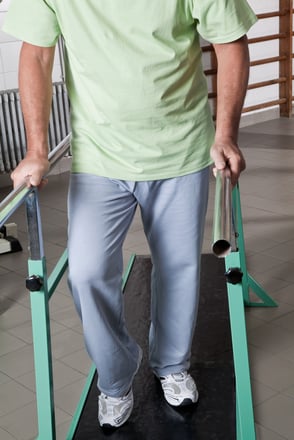- Help Center
-
1-800-774-7785Login

Blog

Zach, a physical therapist’s assistant currently on assignment in San Angelo, Texas, loves helping patients. When Zach first became a physical therapist’s assistant in 2009, he began his career as a Traveling PTA. It gave him the opportunity to pursue his passion, while also offering more employment options with benefits and giving him the ability to see different parts of the country. He joined Jackson Therapy in 2016 after partnering with Katie his recruiter, and began assisting patients in Texas in a nursing facility.
In this facility, Zach focused on geriatric patients, which presented some challenges – as their age made it more difficult for them to progress past an injury. Their slow progress can depress morale and cause patients to lose motivation. When they don’t believe in themselves, they heal at a slower rate.
Building hope, one step at a time
When Zach was first paired with a military veteran and ex-sniper
Case Study: How a Travel PTA helped a patient walk again
Jackson Therapy Partners Jackson & Industry Updates, Physical TherapyZach, a physical therapist’s assistant currently on assignment in San Angelo, Texas, loves helping patients. When Zach first became a physical therapist’s assistant in 2009, he began his career as a Traveling PTA. It gave him the opportunity to pursue his passion, while also offering more employment options with benefits and giving him the ability to see different parts of the country. He joined Jackson Therapy in 2016 after partnering with Katie his recruiter, and began assisting patients in Texas in a nursing facility. In this facility, Zach focused on geriatric patients, which presented some challenges – as their age made it more difficult for them to progress past an injury. Their slow progress can depress morale and cause patients to lose motivation. When they don’t believe in themselves, they heal at a slower rate. Building hope, one step at a time When Zach was first paired with a military veteran and ex-sniper
In honor of Black History Month, we’re celebrating the significant contributions Bessie Blount Griffin made to the fields of physical therapy, nursing and forensic science.
Driven to succeed
Born in 1914, Blount was born in Virginia, receiving only a sixth-grade education. Undeterred, she self-taught on a range of subjects, completing a GED and earning an acceptance into college for nursing, according to The Star-Ledger. After finishing her studies,
Black History Month: How a Physical Therapist’s work helped WWII soldiers and changed forensic science
Jackson Therapy Partners Jackson & Industry UpdatesIn honor of Black History Month, we’re celebrating the significant contributions Bessie Blount Griffin made to the fields of physical therapy, nursing and forensic science. Driven to succeed Born in 1914, Blount was born in Virginia, receiving only a sixth-grade education. Undeterred, she self-taught on a range of subjects, completing a GED and earning an acceptance into college for nursing, according to The Star-Ledger. After finishing her studies,
Do you have left over candy from Halloween and want to get rid of it? Keene’s Crossing Elementary  Second Grade will be collecting for a great organization called Operation Shoebox. For those of you who haven’t heard of this wonderful organization please visit their website and check out the great things they do for our troops overseas.
Second Grade will be collecting for a great organization called Operation Shoebox. For those of you who haven’t heard of this wonderful organization please visit their website and check out the great things they do for our troops overseas.
If you have any leftover Hallloween candy, including chocolate (soldiers say they will lick the melted chocolate if they have to), please drop it by Jackson’s office in Orlando by November 16th.
They also need other times that soldiers have listed on the site:
Jackson is collecting your leftover Halloween candy for Operation Shoebox: Deadline 11/16
Amanda Leloudis Jackson & Industry UpdatesDo you have left over candy from Halloween and want to get rid of it? Keene’s Crossing Elementary Second Grade will be collecting for a great organization called Operation Shoebox. For those of you who haven’t heard of this wonderful organization please visit their website and check out the great things they do for our troops overseas. If you have any leftover Hallloween candy, including chocolate (soldiers say they will lick the melted chocolate if they have to), please drop it by Jackson’s office in Orlando by November 16th. They also need other times that soldiers have listed on the site:
Technology in the health care sector is often much more advanced than that on the consumer market. In fact, it was as far back as 2002 that a team of surgeons in New York used a pair of robotic appendages and an internet connection to operate on a patient in Strasbourg, some 8,700 miles away, according to a study found in the National Library of Medicine. As the health care industry uses more and more advanced technology, wearable tech might just be the next step. This is especially likely in the realm of physical therapy.
Basic wearables
Many people already use basic forms of wearable technology every day. The most common piece of wearable tech is probably the activity tracker – a watch-like device that records steps taken, calories burned and sometimes even sleeping patterns.
Are wearable robots the future of physical therapy?
Jackson Therapy Partners Jackson & Industry UpdatesTechnology in the health care sector is often much more advanced than that on the consumer market. In fact, it was as far back as 2002 that a team of surgeons in New York used a pair of robotic appendages and an internet connection to operate on a patient in Strasbourg, some 8,700 miles away, according to a study found in the National Library of Medicine. As the health care industry uses more and more advanced technology, wearable tech might just be the next step. This is especially likely in the realm of physical therapy. Basic wearables Many people already use basic forms of wearable technology every day. The most common piece of wearable tech is probably the activity tracker – a watch-like device that records steps taken, calories burned and sometimes even sleeping patterns.
Latest Articles
- Travel Healthcare With Pets: How to Register an ESA
- Explore Like A Local: Free and Low-Cost Activities for Healthcare Travelers
- What to do if Your Travel Healthcare Contract is Cancelled
- Step Into the Unknown: Your First Travel Therapy Adventure
- Embracing the Adventure of Travel Therapy as an Empty Nester
